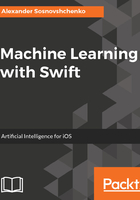
Choosing a good k
It is important to pick a proper value of hyperparameter k, since it can improve a model's performance as well as degrade it when chosen incorrectly. One popular rule of thumb is to take a square root of the number of training samples. Many popular software packages use this heuristic as a default k value. Unfortunately, this doesn't always work well, because of the differences in the data and distance metrics.
There is no mathematically-grounded way to come up with the optimal number of neighbors from the very beginning. The only option is to scan through a range of ks, and choose the best one according to some performance metric. You can use any performance metric that we've already described in the previous chapter: accuracy, F1, and so on. The cross-validation is especially useful when the data is scarce.
In fact, there is a variation of KNN, which doesn't require k at all. The idea is to make the algorithm take the radius of a ball to search the neighbors within. The k will be different for each point then, depending on the local density of points. This variation of the algorithm is known as radius-based neighbor learning. It suffers from the n-ball volume problem (see next section), because the more features you have, the bigger the radius should be to catch at least one neighbor.